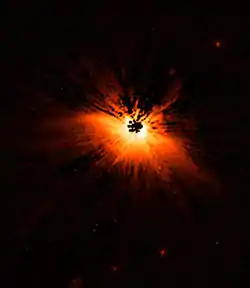HD 61005
HD 61005 is a G8Vk class star[3] in the constellation of Puppis with an associated accretion disk that has helped astronomers understand the process of planetary formation. The particle size and asymmetrical shape of the accretion cloud, have forced a re-evaluation of traditional models of planet formation.[4][5]
 The circumstellar disk of HD 61005 | |
| Observation data Epoch J2000 Equinox J2000 | |
|---|---|
| Constellation | Puppis |
| Right ascension | 07h 35m 47.46192s[1] |
| Declination | −32° 12′ 14.0431″[1] |
| Apparent magnitude (V) | 8.22[2] |
| Characteristics | |
| Spectral type | G8Vk[2] |
| Astrometry | |
| Radial velocity (Rv) | 22.64[2] km/s |
| Proper motion (μ) | RA: -55.71[1] mas/yr Dec.: 74.58[1] mas/yr |
| Parallax (π) | 28.29 ± 0.85[1] mas |
| Distance | 115 ± 3 ly (35 ± 1 pc) |
| Other designations | |
| Database references | |
| SIMBAD | data |
Characteristics
Although HD 61005 is a yellow dwarf like the Sun, HD 61005 is much younger at just 135 million years old,[6] an extremely young age for stars. In this regard, the star retains a protoplanetary disk - the accumulation of the gas-dust matter, forming a planetary system. HD 61005 is located in the Local Bubble - a region with a low concentration of dust clouds.
HD 61005 is 115 light years from Earth, has an apparent magnitude of 8.23 and a metallicity of 72.4% of the Sun. It is moving through the interstellar medium at a speed of 27.4 km/s relative to the Sun[7] and is found in the night sky at right ascension 113.94248° and declination -32.20°.
Protoplanetary disk
In 2007, a team of astronomers announced the discovery of a protoplanetary disk around HD 61005.[8] The disk has an unusual shape, which may be due to the influence of the dense regions of the interstellar medium. The researchers also suggest that the passage through these areas can affect the atmosphere of planets that form. The disc diameter and morphologically resembles a butterfly shape, so it was appropriate for the informal name. Analysis of the data did not confirm the presence of planets in the system.
 Annoted Hubble photo of HD 61005
Annoted Hubble photo of HD 61005
References
- van Leeuwen, F. (2007). "Validation of the new Hipparcos reduction". Astronomy and Astrophysics. 474 (2): 653–664. arXiv:0708.1752. Bibcode:2007A&A...474..653V. doi:10.1051/0004-6361:20078357. Vizier catalog entry
- "HD 61005". SIMBAD. Centre de données astronomiques de Strasbourg. Retrieved 28 December 2016.
- SIMBSD entry for HD61005.
- Dean C. Hines, Glenn Schneider, David Hollenbach, Eric E. Mamajek, Lynne A. Hillenbrand, Stanimir Metchev, Michael R. Meyer, John M. Carpenter, Amaya Moro-Martín, Murray D. Silverstone, Jinyoung Serena Kim, Thomas Henning, Jeroen Bouwman, and Sebastian Wolf, The Moth: An Unusual Circumstellar Structure Associated with HD 61005 The Astrophysical Journal 671 (2007) L165.
- S. Desidera et al. The debris disk host star HD 61005: a member of the Argus association? Astronomy & Astrophysics”. p529 (A54), May 2011
- V. Roccatagliata, Th. Henning, S. Wolf, J. Rodmann, S. Corder, J.M. Carpenter, M. Meyer and D. Dowell Long-wavelength observations of debris discs around sun-like stars.
- HD 61005 (HIP 36948).
- Hines, Dean C.; Schneider, Glenn; Hollenbach, David; Mamajek, Eric E.; Hillenbrand, Lynne A.; Metchev, Stanimir A.; Meyer, Michael R.; Carpenter, John M.; Moro-Martín, Amaya; Silverstone, Murray D.; Kim, Jinyoung Serena; Henning, Thomas; Bouwman, Jeroen; Wolf, Sebastian. The Moth: An Unusual Circumstellar Structure Associated with HD 61005. The Astrophysical Journal, Volume 671, Issue 2, pp. L165-L168. (12/2007).